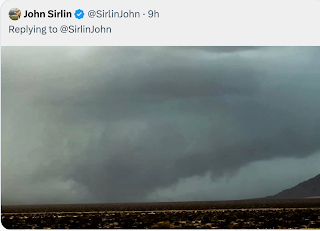Latest Global Warming Problem: Coal Dust
I have repeatedly made the point that, if the pro-global warming forces were confident of their position, they would cut down on the ridiculous claims. Instead, the stream of silly claims continues to grow. Because coal dust is black in color, they reason, it absorbs heat and increases 'global warming.'
Here is the latest from the editorial page of the Eugene, Oregon Register-Guard:
Yes, in the past that might have been an issue. But, as the editorial itself concedes, coal loads are now sprayed to "limit" the amount of coal dust.
Saturday, I took a brand new camera out for the first time. I wanted to get fast-moving objects so I could practice focusing the two new lenses. I practice because, if there is tornado or other important subject, I want to be able to get the shot quickly without thinking.
By coincidence, the very first photos I took were of a BNSF Railway (the railroad that is subject of the editorial) coal train! Here they are, more commentary below:
This is a fully loaded coal train of the type mentioned in the editorial only this train is moving at much higher speed. Two things: See any coal dust coming out the cars? See any coal dust on the ground along the right-of-way?
This track sees at least one coal train every single day! Yet, no coal dust. Zero. Zip.
To further demonstrate my point, here is a telephoto lens image taken down the length of the train. Even though the lens exaggerates these effects, you still don't see any coal dust.
One would think that, if these groups were sincere in their concern, they'd at least go out to the track to see if there were significant deposits along the track or blowing out of the cars. It would take a lot of coal dust to affect the climate. There is no perceptible pollution.
The spraying of the coal loads has worked very well to limit the amount of dust. Case closed.
Here is the latest from the editorial page of the Eugene, Oregon Register-Guard:
Then there’s the disturbing issue of coal dust pollution. Coal trains can lose up to 3 percent of their loads in dust blowing from cars, potentially damaging the health of residents and the productivity of local farms, and degrading the overall quality of life.
Supporters note that railroads have a new rule requiring mines to spray loads with a surfactant that limits dust drift, but the operative word here is “limit,” not eliminate.
Yes, in the past that might have been an issue. But, as the editorial itself concedes, coal loads are now sprayed to "limit" the amount of coal dust.
Saturday, I took a brand new camera out for the first time. I wanted to get fast-moving objects so I could practice focusing the two new lenses. I practice because, if there is tornado or other important subject, I want to be able to get the shot quickly without thinking.
By coincidence, the very first photos I took were of a BNSF Railway (the railroad that is subject of the editorial) coal train! Here they are, more commentary below:
This is a fully loaded coal train of the type mentioned in the editorial only this train is moving at much higher speed. Two things: See any coal dust coming out the cars? See any coal dust on the ground along the right-of-way?
This track sees at least one coal train every single day! Yet, no coal dust. Zero. Zip.
To further demonstrate my point, here is a telephoto lens image taken down the length of the train. Even though the lens exaggerates these effects, you still don't see any coal dust.
 |
| Note: There are two locomotives at the end of the train pushing it (pictured above) as well as the locomotives at the front of the train pulling it. |
The spraying of the coal loads has worked very well to limit the amount of dust. Case closed.







Mike,
ReplyDeleteThanks for the article and the pictures.
In addition to the surfactant, the coal cars are loaded in such a way to give the coal surface a specific contour so as to minimize loss due to wind friction.
Also, the railroads have a very high interest in minimizing coal dust losses. Significant coal dust accumulation along the rail lines will lead to deterioration of the railway bed, and obviously lead to increased costs for the railroad.
But, but, but Mike...
ReplyDeleteIt's the dust you can't see that will get you!
I grew up next to train tracks headed towards downtown Chicago. There were no less than 3 coal trains per day, fully loaded (and the return trip with 'em empty).
No coal dust!